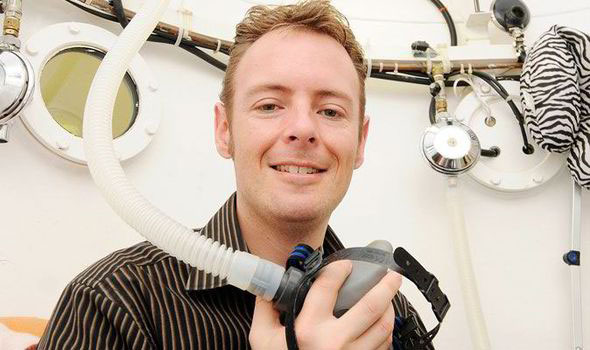Fresh air relief for multiple sclerosis patients. Can regularly inhaling pure O2 help ease the symptoms of multiple sclerosis?
Every week Brendan Hilton steps into a high-pressure chamber, pulls a mask over his face and breathes in a high dose of oxygen. The 32-year-old, who suffers from multiple sclerosis, has found that the treatment eases symptoms of the incurable disease. [Article from the Express]
In the UK and Ireland about 5,000 patients regularly have oxygen therapy lasting about an hour in chambers holding up to 12 people.
It uses the same technology as in the pressurised cabins of passenger jets and some research suggests that delivering high doses of pure oxygen can reduce inflammation which is a key feature of MS.
The treatment is offered at more than 60 centres throughout the UK, each run as an individual charity.
“I feel energised and sleep better after having oxygen,” says Brendan, a former car mechanic who was diagnosed with the disease seven years ago. He initially noticed that he was suffering from double vision but it took six years for the cause to be established.
“I was playing pool on holiday and couldn’t see the balls properly,” he explains. “I was also suffering from headaches. It happened again at work about a year later.” Tests revealed a swelling on the nerve ending behind the eye. It was treated purely as a vision problem but is one of the first signs of MS.
Brendan adds: “It would flare up occasionally, then my mum pointed out that I was crossing my feet when I was walking. I realised it was due to a weakness in my right hip.”
Finally following an MRI scan Brendan was called in urgently by a neurologist and told he had MS, a condition that affects the central nervous system including the brain, spinal cord and optic nerves.
“My first reaction was disbelief and I thought they had mixed up my medical records,” says Brendan. “I didn’t know much about MS and assumed I would end up in a wheelchair but as I learned more, I was determined to get on with life.”
Brendan improved his diet, began exercising more and now rarely drinks alcohol. He also heard about the network of more than 60 MS Therapy Centres in the UK. They offer a range of treatments including oxygen therapy.
“I am open-minded and oxygen therapy made a lot of sense,” says Brendan. “If you have an accident, oxygen is the first thing they give you. It’s not a cure but I’ve no doubt that it helps.”
Some studies suggest the treatment helps ease symptoms such as incontinence, pain and fatigue. However oxygen therapy divides medical opinion and is not available on the NHS for MS.
Possible Benefits
Oxygen therapy can ease symptoms, but only in some patients.
Oxygen treatment is not a cure and people need to be realistic. If you are in a wheelchair it’s not going to get you walking again
The use of oxygen to treat MS was introduced in the UK in Dundee in 1982. For reasons that are not clear but may be linked to lifestyle and climate, Scotland has one of the highest rates of MS in the world.
Petra Kliempt, co-ordinator for MS Therapy Centres, says: “Oxygen is the body’s antibiotic. It helps against infection and the inflammation caused by MS.”
The chambers used at the centres deliver air which is pressurised at twice the normal atmospheric level. This allows high doses of oxygen to reach and repair damaged tissue.
Some studies suggest that over a long period oxygen can slow the effects of MS. It is also claimed that the therapy can stimulate the production of stem cells which may allow some of the damage caused by MS to be repaired.
“Treatment tends to be more successful if begun soon after diagnosis.”
Hyperbaric oxygen therapy was first used in 1887 to treat pneumonia and since the 1930s for deep-sea divers suffering from decompression sickness. It has also been used to help treat a range of illnesses and conditions including stroke, diabetes and brain injury.
Other studies have cast doubt on the treatment but Petra adds: “There are clear benefits and no side effects. I have not encountered any MS patients who report no improvement and for some it is dramatic.”
“People have reported that the effects are like having a fog cleared from around their brain.”
“However oxygen treatment is not a cure and people need to be realistic. If you are in a wheelchair it’s not going to get you walking again. We do believe this treatment should be made available on the NHS but there is a lack of awareness among GPs while others are sceptical about the importance of using oxygen in treatment.”
Ed Holloway of the MS Society says: “Some people with MS who receive hyperbaric oxygen therapy have found that it helps to improve their symptoms but others haven’t found any benefit.
“There have been a number of studies looking into its potential benefits but overall they haven’t found any clear evidence that it is an effective treatment.”
Most patients have an intensive introductory course of 20 hour-long sessions then scale back depending on their symptoms. Anyone having the treatment is asked to make a small donation.
There are about 100,000 MS sufferers in the UK so oxygen therapy is still only being used by a fraction. The condition occurs most commonly in people aged between 20 and 40 and twice as many women as men are affected.
Brendan, who has the relapsingremitting form of MS, has oxygen therapy at a centre near his home in Hereford alongside conventional drug treatment. Although he still struggles with his balance due to leg weakness his condition is now more stable and he is able to enjoy hobbies including fishing. Next year he is due to get married to Helen, a supervisor at the centre.
He says: “If I miss a session I really notice the difference. Even with oxygen treatment I still have times when I can’t face the world and just have to take it easy.”
“However when you have an incurable condition anything that works for you has to be worth it.”
Original article by: Adrian Lee | Published: Tue, January 7, 2014 | Daily Express
Visit msntc.org.uk or call 0845 367 0977 for more information about MS centres and oxygen therapy

